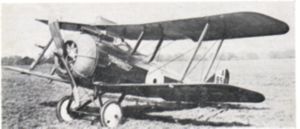Airco DH.5 Video - With DH.2
|
|
Airco DH.5
Airco DH.5

Picture - A standard production DH.5
Role: Biplane fighter
Manufacturer: Aircraft Manufacturing Company (Airco)
Designed by: Geoffrey de Havilland
First flight: August 1916
Introduced: May 1917
Primary user: Royal Flying Corps
Number built: 552
The Airco DH.5 was a British First World War single-seat fighter aircraft specifically designed to replace the obsolete Airco DH.2. The DH.5 was one of the first British fighter designs to include the improved Constantinesco interrupter gear to allow a forward-firing machine gun to fire through the propeller arc more effectively than the older mechanical gears. Although developed rapidly, by the time of its operational introduction, other superior aircraft were available and its service life was short.
Design and development
Captain Geoffrey de Havilland designed the Airco DH.5 to combine the superior performance of a tractor biplane with the excellent forward pilot visibility of a "pusher" type. To facilitate this, the mainplanes were given 27 inches of backward stagger with the lower wing positioned forward of the upper wing. The overall construction was a conventional tractor biplane configuration with a single forward-firing .303 in (7.7 mm) Vickers machine gun, equipped with the Constantinesco interrupter gear, mounted on top of the cowl (offset to the left). In the prototype armament installation, the gun was either fixed to fire upward at an angle, or possibly mounted so that its elevation could be adjusted in flight, however in the production installation the gun was fixed to fire in the line of flight in the conventional manner. As the pilot was seated forward of the centre of gravity, the main fuel tank was located behind the cockpit, below the oil tank (an auxiliary gravity fuel tank was also fitted over the top mainplane, offset to the right).
By the time the prototypes of the DH.5 underwent service trials in December 1916 in France, superior types such as the Sopwith Camel and the Royal Aircraft Factory S.E.5 were not far behind. In fact, the new fighter was inferior in most respects to the earlier Sopwith Pup. The provision of a single machine gun at a time when most fighters carried two also meant the aircraft was also somewhat under-armed for operations in 1917. Nonetheless, the DH.5 was ordered in quantity from four manufacturers: Airco (200), British Caudron (50), Darracq (200), and March, Jones & Cribb (100).
Operational history
In service the type proved unpopular - its unconventional appearance led to rumours of handling difficulties, and its performance rapidly dropped off at altitudes over 10,000 ft (3,000 m). It tended to lose altitude quickly in combat. The unusual position of the upper mainplane also led to turbulence around the cockpit, which affected overall performance. However, the robustness of the construction, fully aerobatic capabilities, and the pilot's good forward field of view made the aircraft a useful ground attack aircraft. In this role, the type served with distinction in the Battle of Cambrai. In August 1917, DH.5s of No. 41 Squadron RFC greatly assisted an infantry attack near Boiry Notre Dame, by strafing enemy trenches and machinegun emplacements.
No. 2 Squadron of the Australian Flying Corps also received DH.5s as its initial equipment, serving mainly in the ground attack role until December 1917, when they were replaced with S.E.5a fighters.
By this time, the DH.5 was already in the process of wholesale withdrawal from the Western Front - the last DH.5 squadron receiving the S.E.5a in January 1918. DH.5s issued to training units proved unpopular, and the type soon vanished from RFC service.
None have survived to the present day, and the only representative example is an airworthy full-scale replica, built in the United States by John Shiveley and currently on display in the Aviation Heritage Centre, Omaka Aerodrome, New Zealand.
Military operators
Australia
Australian Flying Corps
No. 2 Squadron AFC (a.k.a. No. 68 Squadron RFC) in France.
No. 7 (Training) Squadron AFC in the United Kingdom.
United Kingdom
Royal Flying Corps
No. 24 Squadron RFC
No. 32 Squadron RFC
No. 41 Squadron RFC
No. 64 Squadron RFC
No. 65 Squadron RFC
Specifications
General characteristics
Crew: 1
Length: 22 ft 9 in (6.94 m)
Wingspan: 25 ft 8 in (7.82 m)
Height: 9 ft 1 in (2.77 m)
Wing area: 212.1 ft² (19.7 m²)
Empty weight: 1,010 lb (458 kg)
Loaded weight: 1,492 lb (677 kg)
Performance
Maximum speed: 102 mph at 10,000 ft (164 km/h at 3,000 m)
Service ceiling: 16,000 ft (4,800 m.)
Rate of climb: 12 min to 10,000 ft / 27 min 30 sec to 15,000 ft (12 min to 3,000 m / 27 min 30 sec to 4,500 m)
Armament
Guns: 1 x— 0.303 in (7.7 mm) Vickers machine gun
Bibliography
Bruce, J.M. Warplanes of the First World War Vol. 1. London: MacDonald, 1965, p. 128-132.
Jackson, A.J. De Havilland Aircraft since 1915. London: Putnam, 1962.
Lamberton, W.M. et al. Fighter Aircraft of the 1914-1918 War. Lethworth, Herts, UK: Harleyford, 1960, p. 42-43.
Taylor, John W.R. "D.H.5". Combat Aircraft of the World from 1909 to the Present. New York: G.P. Putnam's Sons, 1969. ISBN 0-425-03633-2.
Airco DH.5 Pictures and Airco DH.5 for Sale.
Living Warbirds: The best warbirds DVD series.
Source: WikiPedia